Issue 3 | March 2022 | Climate Change
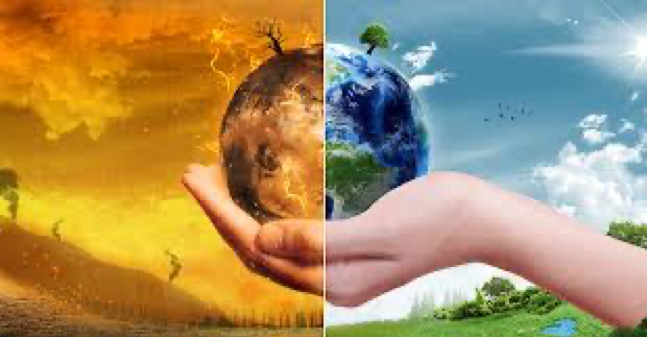
By Elvia Thompson, Annapolis Green
The facts around climate change are daunting and often depressing. But we can all take steps in our everyday lives that will mitigate its effects and, therefore, feel like we have some control. “How can anything I do make a difference?” you ask. Multiply your actions by hundreds or by thousands of other people doing the same and yes, you can make a difference, especially if that action includes telling your elected representatives what steps you want the government – federal, state, and local – to take. But more about that later in this article.
Like COVID, the climate crisis is here whether you believe in it or not. We are seeing severe weather, fires, 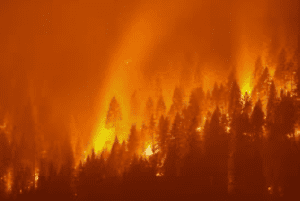 droughts, frequent storms that strengthen in a flash, acidifying oceans, unpredictable weather, and sea level rise. It’s a lot. But here are some things you can do that will do some good.
droughts, frequent storms that strengthen in a flash, acidifying oceans, unpredictable weather, and sea level rise. It’s a lot. But here are some things you can do that will do some good.
The burning of fossil fuels is the engine that drives changes to our climate due to the greenhouse gases they produce, such as carbon dioxide, that trap heat in our atmosphere. Slowly, public opinion is changing and many people, companies and governments are realizing that we need to get off the petroleum diet. The petroleum companies see the changes taking place in public opinion and public policy and are extracting more and more oil to make plastics while they brag about how they are reducing their carbon footprint. Don’t believe it. The harm to our planet caused by a tsunami of plastic continues to grow. Simply put, we are drowning in plastic and our environment is paying the price. We pay the price too because damage to our environment means damage to our own health.
A Few Simple Things You Can Do That Make a Difference
Reduce your use of plastic – it’s about your health too. Plastic, made from oil, is a magic material – it’s strong and lightweight and needed in certain applications, like in medical equipment. But production of plastic continues to increase as does plastic litter in our landfills, on our streets, and even more tragically, in our waterways. To make matters worse, very little of the plastic that can be recycled (and not all of it can) is actually recycled. There are other global issues around recycling too.
Remember that plastic does not break DOWN. Instead, it breaks UP into microscopic pieces that wildlife like fish mistake for food. In fact, there is plastic in our bodies now because of what we ingest. 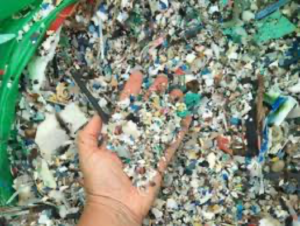 But there are plenty of ways to reduce how much of it we use, particularly the single-use plastics. How about saying no to plastic bags, plastic cutlery, and to the to-go coffee cups that are lined with plastic? Bring your own reusable cup to the coffee shop, keep compostable or metal cutlery in your car for take-out, and shop with reusable bags.
But there are plenty of ways to reduce how much of it we use, particularly the single-use plastics. How about saying no to plastic bags, plastic cutlery, and to the to-go coffee cups that are lined with plastic? Bring your own reusable cup to the coffee shop, keep compostable or metal cutlery in your car for take-out, and shop with reusable bags.
My pet peeve: plastic water bottles. We are very lucky in this area that our tap water is safe and easily available. Don’t spend outrageous amounts of money for 12.9-oz. bottles of water that take you seconds to consume only to stay in our environment forever. Please, get a reusable water bottle, fill it up at home (or at many locations on the go) and skip the plastic.
Household staples are available in forms that do not include plastic containers. Shampoo and conditioner are available in cakes that look like bar soap. Toothpaste is available in small pills that dissolve when you chew them and turn into toothpaste without the plastic tube. Detergent is available in small sheets reminiscent of fabric softener sheets. Fabric softener sheets can be replaced with wool balls in your dryer.. There are sources, such as local Refill Goodness, where you can buy detergents and other products in bulk and take them home in your own bottles thus not buying a new plastic one every time. Try it!
Replace plastic film in the kitchen with waxed wraps. And don’t cook food in plastic bags even if the manufacturer says you can. Heated plastics release chemicals into your food. And consider replacing your non-stick cookware (especially if it’s scratched or peeling) with stainless steel or ceramic to keep chemicals out of your body.
Save Energy. While the electrical grid is getting cleaner all the time as renewable energy grows, the fact is that a lot of our power still comes from burning coal. That makes it even more important to use less by setting your thermostat to reasonable temperatures, turning out the lights when you leave a room, lowering the temperature of your water heater, and all the other things your parents told you to do when you were a kid.
Save Water. In our area, we don’t have the drought problems experienced out west; but that doesn’t mean we should take clean, fresh water for granted. Scientists tell us that we are pulling water out of the aquifers faster than we are replenishing them. So, save water! That also results in saving energy since it takes energy to purify water.
Electrify Your Ride. Transportation accounts for the bulk of greenhouse gases in our atmosphere. One of the best steps you can take to mitigate the effects of climate change is to drive an electric vehicle (EV). There are many affordable models and a lively pre-owned market. Although most EV drivers charge at home, the network of chargers in our area grows daily. You can now charge up in many shopping areas and garages. Driving electric is perfectly normal now, and it’s fun. It’s also good for your wallet. There is almost no maintenance required for these vehicles so your cost of operation is much lower than for a fossil-fueled vehicle. A great deal of information about driving electric is available at these websites: Annapolis Green, Maryland EV, and EVA/DC
Plant Trees. Trees are Nature’s best tools to draw down carbon dioxide from the atmosphere, hold the soil in place, cool the land around them, and provide habitat for biodiversity. Make planting at least one tree a bucket list item for your life.
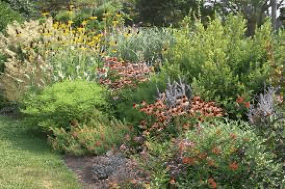 And while you’re at it, reduce or totally remove the lawn on your property. Turf does little for the environment, requires a lot of water, and is often doused with synthetic fertilizer that washes into our waterways with disastrous results. And, most mowing equipment is fossil-fueled with incredibly dirty motors. If you have to maintain turf, at least get a battery powered electric mower. Installing native plants and vegetables makes a lot more sense particularly for biodiversity reasons, but please, no pesticides.
And while you’re at it, reduce or totally remove the lawn on your property. Turf does little for the environment, requires a lot of water, and is often doused with synthetic fertilizer that washes into our waterways with disastrous results. And, most mowing equipment is fossil-fueled with incredibly dirty motors. If you have to maintain turf, at least get a battery powered electric mower. Installing native plants and vegetables makes a lot more sense particularly for biodiversity reasons, but please, no pesticides.
Eat Less Meat. It takes a great deal less energy to grow plants than it takes to grow animals to eat. And emissions from animals, especially beef, greatly contribute to global warming by emitting methane, a potent greenhouse gas. Also, inhumane industrial meat and poultry production includes the use of antibiotics and other substances that are then passed to humans who consume the meat. Plant-based diets are much better for your health and the planet’s.
Make Your Voice Heard. We, as individuals, can take steps such as those suggested here to mitigate the effects of climate change locally but the bulk of the “heavy lifting” will be done by the commercial marketplace and by the government. The marketplace is already making big changes. Companies are investing in wind turbines, installing solar farms, and manufacturing electric cars, trucks, motorcycles, and bicycles. Government policies are changing to ban nonrecyclable expanded polystyrene (Styrofoam) and requiring utilities to provide power derived from renewable sources and more. In this year’s Maryland General Assembly, there are over 60 environmental bills under consideration. Legislators need to know what is important to all of us. Get to know your federal, state and local legislators and tell them how you want them to vote on environmental matters.
Stay informed about climate change issues. This is the most serious crisis facing humankind. The warming of our planet is already baked in with the level of greenhouse gases in the atmosphere now and it’s increasing with every passing minute. Earth will be a very different place in just a few years. Taking steps to mitigate the effects of climate change is not about saving the planet. It is about saving us, making sure that at least parts of our planet are habitable so that our global civilization can continue.
There are two necessary steps. First, we have to understand what is happening. Then we must have the will to use new technologies and common-sense practices to save ourselves. For now, we are in good shape for step one but not so much for step two. As a friend of mine says, no one can do everything, but everyone can do something.
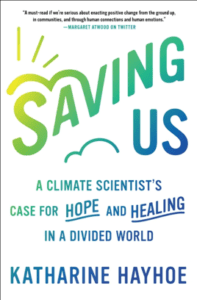 Want to know more and expand your mind? Have a look at the books the Green Reads Book Club has read over the past year since April 2020. They are all good but I would highlight Saving Us: A Climate Scientist’s Case for Hope and Healing in a Divided World by Katharine Hayhoe and would add David Pogue’s How to Prepare for Climate Change: A Practical Guide to Surviving the Chaos.
Want to know more and expand your mind? Have a look at the books the Green Reads Book Club has read over the past year since April 2020. They are all good but I would highlight Saving Us: A Climate Scientist’s Case for Hope and Healing in a Divided World by Katharine Hayhoe and would add David Pogue’s How to Prepare for Climate Change: A Practical Guide to Surviving the Chaos.

